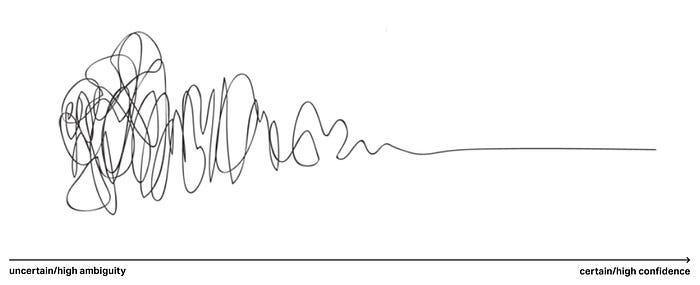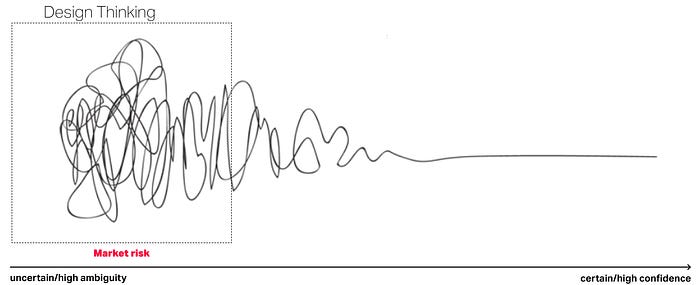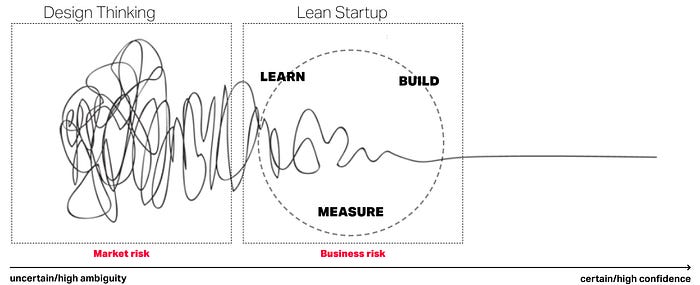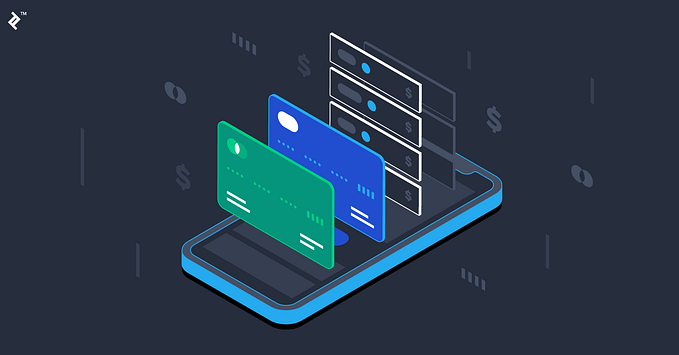Combining lean startup and agile with a design-led approach reduces business risk.
For most corporations, leading in quality means continually pursuing organizational excellence. This means leaders have to make sure that the organization is fit for its purpose, stays that way, and keeps improving over time. Maintaining quality is much easier when the risks involved are lower. Organizations tend to reduce risk by defining things that can be measured and incentivized. The side effect of this, however, is that organizations become increasingly risk-averse. Lower risk means more profit and happier shareholders. However, they also need to stay competitive. So risky adventures are often externalized to partners in design and strategy consulting firms.

In the last few years, however, there has been an uptick in the number of design agencies and companies acquired by corporations or consultancies. Data shows that between 2004 and 2012, there were only 11 mergers and acquisitions of design firms, approximately one per year on an average. Between 2013 to 2016, however, this increased to 49, approximately 16 per year. In 2017 alone, new acquisitions rose to 21 design and creative companies. (source: Design in Tech report 2017 and 2018).
One way to see this uptick is that more and more organizations are looking to build design capability in-house in an attempt to marry innovation performance with operational efficiency. Bringing capabilities in-house allows organizations to combine existing subject matter expertise with the innovation mindset that designers bring with them and innovate continually.
The problem is what happens after the acquisition. Such capability matching is easier in younger, nimbler, fast-growth tech companies (such as Uber, Facebook, Google, Airbnb) than in mature, stable growth, hierarchical organizations (such as GE, Adobe, Wipro, IBM, Accenture, Deloitte). These companies carry practice mindsets that have been established over many years of experience. Further, a focus on shareholder value, structural hierarchies, and internal politics often lead to resistance to change.
Another key element to consider in this transition is that design is not the only capability that is acquired. Each discipline within the company is trying to re-invent itself by bringing in methods and frameworks that promise cost-effective, faster and customer-centric way of working in an attempt to create the “new.” The digital group is eager to introduce Agile methodologies in how they develop new solutions. Design teams bring in Design-led innovation to the organization. Product management and strategic leadership introduce Lean Startup methods into the same innovation pipeline. Not only does this create confusion but also leads to severe impairment of the innovation process.
What if there is a way to govern innovation by combining these methods using a design-led approach? In the end, each method enables faster, cheaper and replicable-at-scale processes. How can Design help us be better and more efficient? How can Design and Lean Startup approaches coexist? What does lean mean in the context of innovation? How do you combine Agile and Design approaches? What is the role of the designer in all of this?
I am not the only person to think about these questions. Gartner introduced a model combining Design thinking, Lean Startup and Agile during the Gartner Symposium in 2016. Board of Innovation too has written extensively on this topic and claim “the challenge for organizations and project teams, however, is to understand how to use these methodologies optimally and when to shift up and iterate back and forth from one to the other. For their decisions, teams must rely upon specific innovation accounting, pre-defined KPI’s and experimentation validation metrics.”

Innovation governance is critical for organizations to benefit from integrated design capabilities. To explain governance, let’s start by looking diagrammatically at the innovation process. The squiggly line (above) is meant to illustrate the characteristics of the innovation process — uncertain in the beginning but converging in the end to a single point of clarity. From a design perspective, this means a divergence and convergence of ideas as we move from high uncertainty to high confidence in our solution. This progression is key to creating a successful unified model between Design thinking, Lean Startup, and Agile methodologies.
In the following section, I will show how design plays a role in innovation governance — what questions need to be asked, what methods can be engaged, and what pitfalls are to be expected in each part of the process.
Start with Design Thinking to ensure that solutions create new value for users
“Design thinking is a human-centered approach to innovation that draws from the designer’s toolkit to integrate the needs of people, the possibilities of technology, and the requirements for business success.”
— Tim Brown, CEO of IDEO.

How and when does it start?
Design thinking is applied at the very beginning of the innovation process. Design thinking goes beyond a founder’s vision or product-in-hand. It starts with defining the problem, finding the need, and then formulating what to build. Design thinking is about understanding the needs of the user to reduce market risk.

Questions asked
- What should I make?
- Who is it for?
- Why will it create value?
- How should I make it?
Design Thinking in the innovation process
- Brings a human-centered lens and builds empathy with users/customers.
- Helps clarify the real problem and challenges the status quo.
- Focuses on uncovering unarticulated needs of the user.
- Engages in systems thinking and takes a big picture view.
- Helps understand the value of the problem to the user early in the process.
- Engages users through a series of speculative prototypes and minimize uncertainty and risk of innovation.
- Provides a new lens for evaluation of ideas to balance desirability, feasibility, and viability.
Role of Designers
(UX) Design Researcher, Design Strategist: Understand context, facilitate problem framing, define opportunities, and understand customer value.
UI Designers, Product Designers, and Managers: Storytelling and communication. Create early concepts to help demonstrate the problem framing.
SKILLS: Design research, market research (Era analysis, Trends analysis), research storytelling/communication, facilitation of co-creation workshop.
METHODS: Competitive landscape, Service blueprints (Service Design), Stakeholder ecosystem maps, Value webs, Customer value maps, STEEP analysis, Behavioral typologies and Personas, Customer journey maps (5Es framework), AEIOU, POEMS framework, etc.
Potential pitfalls of Design Thinking
Design Thinking requires organizations to be tolerant of high levels of ambiguity. Design is about challenging and questioning the initial premise and problem frame. Larger organizations focused on efficiency often are not comfortable with this kind of uncertainty creeping into any part of the process. Due to this, the design perspective is generally applied after all key product and business decisions have been made. It is seen as an aesthetic function — “we know what to do, you just make it beautiful.” This is counter to what Design wants to do. It leaves little room for negotiation or change and leads to conflict between the design team (interested in framing the problem correctly) and product owner/manager (interested in getting the best product out of the door).
Engage Lean Startup methods to experiment and pivot until you find a market fit and reduce business risk

“Lean start-up” is a method that favors experimentation over elaborate planning, customer feedback over intuition, and iterative design over traditional “big design up front” development. The Lean Startup method teaches us to think like a startup, learning how to steer, when to turn, and when to persevere and grow a business with maximum acceleration.
How and when does it start?
Lean Startup starts when a strong product vision has been defined. At this point, needs and values have been defined, and the idea or technology is looking for market fit. Using Lean Startup, stakeholders continuously pivot until they find the right fit using a rigorous method-based approach. Lean Startup is about understanding market fit and reducing business risk.
Questions asked
- Should this product be built?
- Is there a market fit for the idea/solution?
- Can we build a sustainable business model around the conceived set of products and services?
Lean Startup in the innovation process
- Provides a method-based approach to creating and managing startups
- Ensures that a startup can minimize expenditure of time, money and effort (often wasted) by working in smaller iterative sequences.
- Eliminates waste and improves production
- Focuses on customer validation
- Introduces the build-measure-learn (BML) cycle in the innovation process
- Promotes experimentation and failure while continually pivoting to find the fit.
- Brings a higher level of confidence to the product vision and concepts that are taken into development
Role of Designers
(UX) Design Researcher, Design Strategist: Advocate for the end users/customers, facilitate a balance between business needs and user needs, assist the business model and value proposition conversations through customer research. Help the team understand workflows and the construct of the whole system where the solution will be embedded. Work across business units to understand if there are possibilities to combine existing solutions to solve the problems. Work with prospective customers to learn how the solution could fit in their existing ecosystem as well as barriers to a smooth transition and successful adoption.
UI Designers, Product Designers, and Managers: Create concept prototypes to align and communicate the idea, storytelling, and communication that elicit (both internal and external) customer feedback throughout the entire process
SKILLS: Value stream mapping, design research, storytelling, market research, design concepts, and prototypes, facilitate solution workshops, usability testing
METHODS: Business Model Canvas, Value proposition canvas, Minimum Viable Product (MVP)
Potential pitfalls of Lean Startup
Lean Startup was developed as a method to enable entrepreneurs succeed by pivoting ideas to create a market fit. The emphasis of the build-measure-learn (BML) model favors validation over need-finding. It does not create new ideas and tends to look at the user value through a product lens. It is about transcribing known values into actual dollars. If Lean Startup methods are applied without understanding user need, it increases the risk of failure. Design’s role in this process is to be an advocate of the user (where you bring value) without sacrificing the business aspects of the process (how you make money).
Bring in Agile methodology for faster and adaptive development of the idea into a product

Agile product development is used most commonly in the context of software or digital project development. It is a methodology that ensures agility, flexibility, and adaptability during development using small batch productions to create a minimum viable product (MVP). The priority is to focus on desired customer outcomes where lower-fidelity systems evolve into higher-fidelity system leading up to an MVP.
How and when does it start?
Agile models should ideally start after a product vision has been loosely established, and the product owner has an idea of what product will be taken to market, how it will make money, and what it will look like. Agile developers cannot be encumbered with ambiguous decision making or challenging of values and problem frame. Agile is most helpful when product guidelines, specifically, the stories and features have clear acceptance criteria, and there is a shared understanding of what the deliverable is. The Agile process is about having a working product that can be taken to market at any given time.
Questions asked
- What are our objectives and key results?
- What should we deliver into the hands of the user and by when? Define MVP.
- What are the desired customer outcomes and after that, requirements and the lists of features? And what are the capabilities and enablers needed?
- How can we improve our overall process via retrospectives?
Agile in the innovation process
- Satisfy the customer through the early and continuous delivery of valuable software.
- Welcomes changing requirements, even late in development for the customer’s competitive advantage.
- Delivers working software frequently in a shorter timescale.
- Expects designers, business people and developers to work together daily throughout the project.
- Defines working software as the primary measure of success.
(Source: http://agilemanifesto.org/principles.html)
Role of Designers
(UX) Design Researcher, Design Strategist: Facilitate building empathy with the customer, organizational stakeholders, and users by keeping the research stories alive throughout the process. Keep the team aligned and close to the purpose. Engage the team in system thinking by visualizing the big picture view. Show them research that supports the problem they are solving and the gains customers will make by the adoption of the product. Caution the team of any trends, regulations, user behaviors that might be a barrier to user adoption.
UI Designers, Product Designers, and Managers: Create design specifications and procure customer feedback. Support development during sprints, attend sprint planning, backlog grooming meetings, meet with product teams to align design with product initiatives. Research and stay up to date on design trends. Test designs with users regularly, ensure designs are accessible and compliant with guidelines. Review copy with the legal team & technical writers, work with design language team to maximize use of consistent design patterns across pages and products. Work with designers on other products to share patterns and workflows, follow industry best practices. Product managers and design need a basic understanding of the technology including back-end systems and front-end development capabilities and constraints.
SKILLS: Continuous design research, market research, trends, and research; Facilitate alignment, interface design and prototyping; design documentation, run usability workshops to elicit feedback.
METHODS: Prototyping, A/B testing, paper prototyping, usability studies.
Potential pitfalls of Agile
Agile is a developer-centric rather than user-centric model, and it focuses on processes for gathering requirements and developing code that works. Agile teams are expected to prioritize features and work on stories logically grouped to create an MVP. Herein lies the risk; poor communication and lack of collaboration often causes teams to lose perspective of the whole view. This can lead to competitive interactions between the design team, the business team, and the agile team; one is looking to maintain user-value, another is looking to maintain business-value, while the other is trying to design for customer outcomes. The role of the designer, in this case, is to facilitate conversations between the agile team and the product leaders. They have to match the design concepts to the cadence of development demanded by Agile and make sure that the teams have a common understanding of both business intent and customer value.
This is not, by any means, an exhaustive list of questions, skills or methods that are needed in each part of the process. The purpose of the article is to demonstrate how the role of designer evolves as teams progress in the innovation process (digital and physical product development). Successful innovation governance is about incorporating different approaches at different times as teams move along the continuum from high ambiguity to high confidence. Alignment within a team is critical, as it helps team members map where the idea is within this divergent and convergent process. A great way to bring alignment to the team is making sure the right questions are asked at the right times during the process. An innovation governance manager also manages the role of design strategists, design researchers, interaction designers, product managers, developers, and engineers by articulating and carefully connecting it to the needs of the process flow.
As Charles Eames put it,
“Any time one or more things are consciously put together in a way that they can accomplish something better than they could have accomplished individually, this is an act of design.”
This article is part 4 of a 6 part series about innovation flow which began with my first insight “Innovation is not ideation.” In the next article, I will further discuss risk and ambiguity as sub-components of uncertainty, and how these are directly related to exploration and experimentation needed within the process.
Please follow my stories on Medium. If you have comments, please leave them below or email me directly at shilpi.kumar@khojlab.com
A special thanks to people who informed my content in this article: Anijo Mathew who helped with editing, and my friends/mentors at GE (Nicole Ciminello, Praseed Prasannan, Mike Alexander, Lavanya Jagadesan) and Herman Miller (Jim Long) who informed my thinking and inspired me to write this article.






